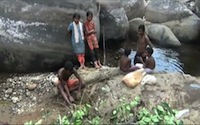The aim of the project is to collect, archive and make available a long lasting and multipurpose multimedia documentation of the language spoken by four distinct Kurumba groups living in different geographical zones of the Nilgiri area and having different socio-economic occupations.
These are
- The Mullu Kurumbas, a numerically larger community being engaged in settled agriculture in the Wayanad. They are representative of a rather modern type of occupation.
- The Alu Kurumbas, dispersed along the Southern border. They are representative of the mainstream tribal situation prevailing along the Nilgiri rim,
- The Cholanaikas of the Nilambur Valley on the southwestern edge of the Nilgiri, being a more isolated group, and
- The Jēnu Kurumbas, dispersed across a wide territory ranging from the Karnataka border in the North to the Kerala Wayanad in the West,
The project will give priority to the linguistic and ethnographic features linked to natural environment, tribal mode of life and specific Nilgiri cultural traditions. Thus, traditional activities and material culture related to subsistence (hunting, fishing, honey collection…), day-to-day life (habitat, dress, food, child care and others) and more formal events (festivals, weddings, healing- and death rituals) will be the focal points of the project.
The primary documents, mainly audio and audiovisual recordings (including narrations, dialogues, songs, ritual discourses….) on the cultural fields mentioned above, will be carefully annotated and organized into relational databases that will allow later enrichments and the incorporation of additional (varieties of) languages.
The linguistic situation of the Nilgiris is particularly complex and though the tribal groups that will be documented have their own distinct set-up, they also share many cultural and linguistic similarities that are characteristic of the Nilgiri as a whole.
To capture the characteristic features of this area without losing its diversity, we cast our collective work into a comprehensive framework, which will allow not only a monographic approach, focussed on one particular language, but also a thematic and trans-ethnic approach to the cultural and linguistic features specific to the area.
Technically, the multi-tier annotation system and relational databases will make it possible to handle the data and make the information retrievable. For instance, a search for ‘honey collection’ will give access to videos showing how different groups practice it, to the audio files and annotated texts (transcript, glosses, translation…) of the narratives and songs related to this activity, to the vocabulary connected to this theme…
The tribal communities will be actively involved in the project, not only as participants/recipients of the documentation on their own groups, but also in an interactive manner: the primary audio and audiovisual documents recorded in other groups will be used as stimuli for verbal comments, hint to similar practices existing in their group and awareness towards the other groups’ culture and language. They will also be the recipients of end products of the documentation project (e.g. CD/DVD or printed material).








